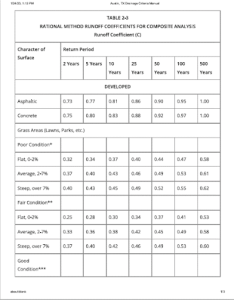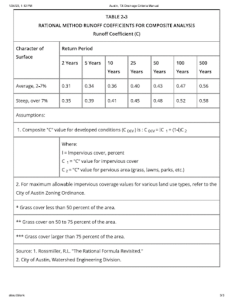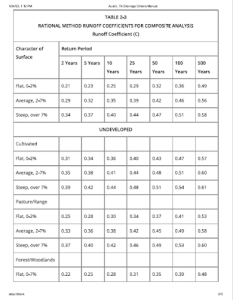The Role Trees Have in Natural Stormwater Management
Written by Sydney Dwoskin, Senior Field Arborist and CAD OperatorHow are trees related to stormwater runoff?
A stormwater plan is often one of the first elements of a site design to be considered. The area is first assessed for existing drainage, and then proposed drainage is planned and adjusted pretty regularly throughout the design process. Stormwater systems are costly, time consuming, and can have catastrophic consequences if designed or built incorrectly. According to City of Austin municode and various other central Texas municipalities, “Stormwater runoff peak flow rates shall not be increased at any point of discharge from a site for the two (2), ten (10), 25 and 100-year storm frequency events”1. This means that the amount of stormwater runoff coming from a site must be equal to or less than it was before the property was developed.
So where do trees come in? Speaking technically, they come in at the “C” of the Rational Method defined as Q p = CiA. In layman’s terms the Rational Method is an equation we use to relate rainfall to runoff. The C in this equation is called the “composite coefficient of runoff” and represents the proportion of rainfall coming off the site that will reach the drainage system. Put reversely, it can be seen as how much of the rainfall will or won’t be absorbed by the site. Developed areas, areas with larger slopes, and areas with little vegetation have a higher C coefficient (tables provided). Without getting too into the nitty gritty on subjects that folks much smarter than me have studied, it means that trees can reduce the amount of stormwater runoff! Given all the flooding happening in central, south central, and south Texas in the past two decades, and the costs of material and labor to build these man made drainage systems, it seems like a no brainer to pair tree preservation with stormwater design. So now that we know trees do reduce stormwater runoff, let’s take a further look into how trees accomplish this and the other benefits they provide within the scope of our stormwater systems.
How do they do it?
From canopy to roots and roots back up to canopy, trees are working hard to redirect runoff from the drainage system. The canopy not only deflects raindrops from hitting the ground directly, thereby protecting from excessive erosion, but it also captures water on the leaves which are later evaporated back into the atmosphere. Actually, it has been found that evergreen species can maximize the amount of water intercepted. Hello, Ashe juniper! The roots stabilize the soil which prevents erosion, but also, they literally uptake water they need to thrive out of the soil. According to the Center for Urban Forest Research, “…a typical medium-sized tree can intercept as much as 2380 gallons of rainfall per year” 2. Apart from reducing the amount of runoff, the water that slowly drips down the canopy, branches, trunk, and then roots has been shown to increase infiltration and thereby groundwater recharge. Lastly, trees can increase the quality of the water released back into the system. “Plants, especially woody plants, are very good at removing nutrients (nitrates and phosphates) and contaminates (such as metals, pesticides, solvents, oils and hydrocarbons) from soil and water. These pollutants are either used for growth (nutrients) or are stored in wood” 3. This is proof that trees are an essential tool we should be using to avoid fertilizers, petroleum hydrocarbons, nitrates, and heavy metals from reaching our watersheds and oceans.
It is clear that trees have the power to not only reduce, but also purify stormwater runoff. The more trees and vegetation in an area, the more water that will be absorbed onsite. The result is an overall lower peak outflow which requires a less robust stormwater plan. As mentioned before, these systems are timely and costly to install, so it begs the question: Why is tree preservation not a part of the stormwater design process in any capacity?
- Austin, Texas – Drainage Criteria Manual – 1.2.2 D
- Center for Urban Forest Research, Pacific Southwest Research Station, USDA Forest Service, Davis, California. July 2002
- Vincent Cotrone – The Role of Trees and Forests in Healthy Watersheds, PennState Extension



